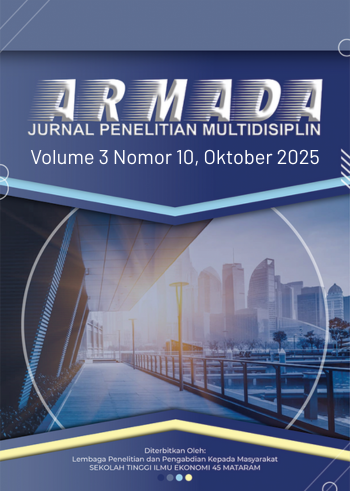Telaah Filsafat Ketuhanan dalam Hulul, Ittihad, dan Wahdatul Wujud sebagai Ekspresi Transendensi Spiritual dalam Tasawuf Falsafi
DOI:
https://doi.org/10.55681/armada.v3i10.1773Keywords:
Philosophical Sufism, Hulul, Ittihad, Wahdatul WujudAbstract
This study discusses in depth the dynamics of philosophical Sufism with a focus on the concepts of hulul, ittihad, and wahdatul wujud as the pinnacle of human ontological awareness of God. These three concepts represent the highest phase of spiritual journey where the boundaries between the divine and the human merge into a unity of existence. This study uses a qualitative-philosophical approach with a Sufi hermeneutic model to interpret the inner meaning of classical Sufi texts such as the works of al-Hallaj and Ibn 'Arabi. The data were analysed through three stages of interpretation: exoteric (textual), esoteric (symbolic), and transcendental (ontological). The results show that philosophical Sufism not only contains metaphysical aspects, but also epistemological and spiritual values that build a dynamic relationship between reason and intuition. Through an understanding of hulul, ittihad, and wahdatul wujud, humans are guided to realise that their existence is a reflection of divine reality. Thus, this study affirms that the unity of existence is not the loss of human existence, but rather the unification of consciousness in the presence of an absolute and comprehensive God.
Downloads
References
Abd Rasyid, N. (2020). The Concept Of Al-Wihdatul Wujud Ibnu Arabi (A Sufistic Philosophical Study). HUNAFA: Jurnal Studia Islamika, 17(1), 72–87. https://doi.org/10.24239/jsi.v17i1.582.68-83
AbdRahman, B. (2018). Martabat Tujuh Sebuah Ontologi Sufi. Dirasat, 13(2), 6.
Andariati, L. (2020). Aliran- Aliran Dalam Tasawuf. FiTUA: Jurnal Studi Islam, 1(2), 132–146. https://doi.org/10.47625/fitua.v1i2.258
Azhar, M., & Rohman, S. M. (2022). Konsep tasawuf wahdat al-wujud menurut hamzah fansuri. Indonesian Journal of Muhammadiyah Studies (IJMUS), 3(2), 73–89. https://doi.org/10.62289/ijmus.v3i2.46
Chittick, W. C. (1989). The Sufi path of knowledge: Ibn al-‘Arabi’s metaphysics of imagination. State University of New York Press.
Corbin, H. (1993). Alone with the alone: Creative imagination in the Sufism of Ibn Arabi. Princeton University Press.
Daud, S. M. (2021). Hukum Objek dan Kausa Dalam Perjanjian (Sebuah Perbandingan Antara Hukum Perdata dan Hukum Islam). Islam & Contemporary Issues, 1(1), 59–64. https://doi.org/10.57251/ici.v1i1.79
Devi Umi Solehah. (2021). Konsep Pemikiran Tasawuf Falsafi (Ittihad, Hulul Dan Wihdatul Wujud). Islam & Contemporary Issues, 1(2), 1–8. https://doi.org/10.57251/ici.v1i2.53
Fauzi, R. (2021). Analogi dalam Interpretasi Wahdatul Wujud dan Implikasinya dalam Kehidupan. Hikamia, 1(2), 1–23.
Hasanah, U. (2015). Wahdat, Konsep Ibn, Al- Wujūd Dan, Arabī Kawulo, Manunggaling Gusti, L A N. Semarang, 185.
Indra Purnamanita, E. I. (2023). Kajian Tasawuf Falsafi Mengenai Wahdat al-Wujud Ibn Arabi (1165-1243 M). TIN: Terapan Informatika Nusantara, 4(6), 345–349. https://doi.org/10.47065/tin.v4i6.4629
Kusuma, A. R. (2021). Konsep Hulul Menurut Al-Hallaj Dan Penempatan Posisi Tasawuf. Jurnal Penelitian Medan Agama, 12(1), 45. https://doi.org/10.58836/jpma.v12i1.10488
Lubis, D. M. R. (2021). Konsep Pemikiran Tasawuf Akhlaqi. Islam & Contemporary Issues, 1(2), 28–35. https://doi.org/10.57251/ici.v1i2.88
Maisyaroh. (2019). Tsawuf Sebagai Dimensi Batin Ajaran Islam. XII(2), 141–151.
Matondang, A. R. (2022). Wahhdatul Ulum Sebagai Respon dan Solusi Terhadap Dikotomi Keilmuan. Islam & Contemporary Issues, 2(2), 66–71. https://doi.org/10.57251/ici.v2i2.701
Muhammad Ihza Fazrian, A.Anjasyah, & Sulistiyo. (2024). Konsep Ittiḥād dalam Fabel Mantiq at-Ṭair: Pemikiran Tasawuf Falsafi Farīduddīn ‘Aṭār (1145-1221 M). Refleksi Jurnal Filsafat Dan Pemikiran Islam, 23(2), 166–183. https://doi.org/10.14421/ref.v23i2.5108
Mursalin, M. (2024). Pendekatan Tasawuf Dan Psikoterapi Perspektif Islam. Cons-Iedu, 4(1), 77–90. https://doi.org/10.51192/cons.v4i1.813
Nasr, S. H. (2007). The garden of truth: Knowledge, love, and action. HarperCollins.
Ricoeur, P. (1976). Interpretation theory: Discourse and the surplus of meaning. Texas Christian University Press.
Sahrul, M. R. A., & Santalia, I. (2024). Pemikiran Abu Yazid (Al-Ittihad) dan Al-Hallaj (Hulul). … : Jurnal Studi Islam Dan Ilmu Al …, 2(1), 34–44.
Suryani, I., Ma’tsum, H., Santi, N., & Manik, M. (2021). Rukun Iman dalam Pembelajaran Aqidah Akhlak. Islam & Contemporary Issues, 1(1), 45–52. https://doi.org/10.57251/ici.v1i1.7
Syamhudi, M. H. (2013). Hulul, Ittihad, dan Wahdat al-Wujud dalam Perbincangan Ulama Zahir dan Batin. Al-Tahrir: Jurnal Pemikiran Islam, 13(1), 107–126.
Yanti, R. (2023). Konsep Al-Ittihad Menurut Tasawuf Abu Yazid Al-Bustami. Mushaf Journal: Jurnal Ilmu Al-Qur’an Dan Hadis, 3(3), 415–420.
Zainun Kamaluddin Fakih. (1998). IBN ’ARABĪ DAN PAHAM WAḤDAT AL-WUJŪD. Jurnal Kajian Agama Dan Filsafat, 1(1).
Downloads
Published
How to Cite
Issue
Section
License
Copyright (c) 2025 ARMADA : Jurnal Penelitian Multidisiplin

This work is licensed under a Creative Commons Attribution-ShareAlike 4.0 International License.








